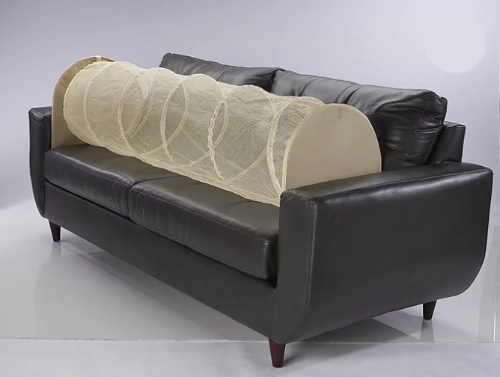Protect backs: ramps ♦️ furniture blockers ♦️ training
We can all take actions which may help prevent or prolong the next disc episode by reducing the stress on the discs in between the vetertebrae of the spine. Some ways of doing that are to limit jumping, and avoid stairs, and training them NOT to fly. Both jumping up or jumping down should be avoided.
“Each time a dog jumps up on the bed, jumps for the ball, or jumps into the back of the SUV, the spine is flexed and then acutely extended, putting increased forces at the low cervical, mid-thoracic, and especially lower lumbar spine. These recurring stresses can result in chronic fatigue and microscopic damage to the IVD.”Scot Swainson, DVM, ACVS Surgeon Colorado Canine Orthopedics

Kiddy/Doggy Gates
Block off places we don’t want our doxies to go, like staircases, by putting up a kiddy or doggy gate at the top and bottom to deny them access.
Furniture
Ramps are preferred over stairs and the best option we can use for furniture and beds.The ramps with rails are best in order to prevent our darlings from taking the most direct route to their destination by jumping off the side of the ramp. Depending on your dachshund’s character and previous habits, you may find that the only workable solution is to block off your furniture altogether with cushions or decorative pillows. Then, when you’re sitting with them, you can better control their descent either by a ramp or by putting them down yourself.

Indoor and Outdoor Ramps
If you have a sunken living room, you might consider installing ramps from the living room up to the other areas of the house. To make them more attractive, you can cover them with the same carpet that you installed on the floor or a nice complementary color.
Many of our homes have steps from the house to the backyard and ramps are, once again, ideal. You aren’t a carpenter or don’t have one in the family? Don’t worry; there are many different types and styles of ramps available in pet stores and on the internet.

-1- Ramp Training for the IVDD Community

FYI: 15%D (BACKSAFETY15) Ramp courtesy from Crusoe, CEO of the Doggo Ramps
Avoid Impact To The Back
Learn the tricks and tips for training your dog to use a ramp.
Want to know where or how to begin training?
Vexed your dog takes shortcut jumps off the ramp?
- Professional trainer: step by step Ramp training article & video
- Forum member discussion on ramps http://dodgerslist.boards.net/thread/867/ramps

-2- Keep all four paws on the ground
Chirag Patel: Four Feet on the Floor: Teaching dogs and puppies to keep their four feet on the floor instead of jumping up. http://youtu.be/XX58DLLLZF8
Best place for our IVDD dogs – the floor
So, the best place for our fur kids is on the floor. And believe it or not, the floor can actually be a comfy, cozy place. Take as many egg-crate mattress toppers as you think will be comfy (3 work well) or a 4-inch memory foam mattress topper and cover it with a quilt, comforter, or blanket. Throw lots of pillows and blankets on top and, voila, you’ve created a comfy, cozy, human/doxie den. (When the weather turns cold, light a fire in the fireplace, get yourself a big mug of hot cocoa with extra chocolate shaved on top, and indulge yourself in a wonderful winter’s eve highlighted by dachshund snuggling.)

DIY Block off furniture

Furniture blockers are yet another idea: lightweight and a no sew project. Look below for DIY instructions
You’ll find what works best for you and your home by experimenting and trying different things. Implementing these changes in your home when your dachshund is still a puppy is certainly easier; but, even if you’re in the IVDD-recovery mode, it’s never too late to start. Granted, some of the these home modifications will not qualify you for the cover of a stylish home-décor magazine; but, they will have a positive effect on the long-term health of your loyal and loving companion.

DIY Furniture Blocker Instructions
by Tracey Gillespie
- I can’t take credit as this idea was suggested to me by another Dodgerslist member, Beverly Phillips. I just modified her instructions to suit my needs, which is what anyone else should do. This may seem like a lot of steps, but it is actually quite easy to assemble. I did not use PVC glue because I want to be able to take mine apart. All materials cost me around $20 for 3 frames that block both sofa and loveseat. Of course, I went to the hardware store so they would cut the pipes for me. Although they did not charge for the cuts, I am sure that you can probably buy cheaper from a lumber company.

My sofa blocker is made in the shape of a rectangle that is about 6″ higher than the couch. The bottom has arms or supports attached so that it will stand up and these slide under the couch. If I want to sit down, I simply move one of the blockers to the side and sit. If I want to let the dogs up on the couch, I just pick them up and let them lay there with me. They do not attempt to jump down because they are blocked.

For each frame you will need
Six pieces of 1/2″ pvc pipe cut to fit (I had the hardware store cut for me)
• Two (2-way) non-threaded 90° elbows • Two (3-way) 90° elbows (I bought with 2 ends unthreaded and 1 end threaded so I could remove arms for storage. • 2 adaptors (from threaded to non-threaded…but you will not need these if you use non-threaded 3-ways) • 2 end caps (optional – I have wood flooring and wanted to protect it from being scratched by the cut ends of the pvc) • Fabric – I used a twin size sheet for each. Any fabric can be used, just remember to measure enough for both sides of the slipcover.*Self-Adhesive velcro or fabric glue (If you do not sew. I sewed mine)
Instructions for each blocker:
• 1 Measure the length of the area you want to block. I made 2 blockers for my sofa, one for each sofa cushion length (see sofa picture) and one for the loveseat (see loveseat picture). For length, measure the length between legs underneath sofa (the blockers need room to slide under sofa). If making two blockers, divide this number by 2. I also subtracted 1/2″ from each side of pvc length to allow for elbows. You will need two pipes for length for each blocker.
• 2 Measure the height of the area you want to block. I measured from floor to top of cushion and then added another 7 inches. You will need two pipes for height for each blocker.

• 3 Measure the length for the arms (supports) I used the same size as height. You will need two pipes for arms for each blocker.
 • 4 Arrange 2 pipe lengths and 2 pipe heights into a rectangle on the floor. Connect top pipe lengths to pipe heights with a 2 way 90° elbow on each side. (See corner
picture).
• 4 Arrange 2 pipe lengths and 2 pipe heights into a rectangle on the floor. Connect top pipe lengths to pipe heights with a 2 way 90° elbow on each side. (See corner
picture).
 • 5 Connect bottom pipe length to pipe heights with a 3 way 90° elbow with threaded end (if used) facing out. (See floor corner picture). Threaded end is not necessary but was all I could find. If you can find non-threaded, then you do not need the adaptors.
• 5 Connect bottom pipe length to pipe heights with a 3 way 90° elbow with threaded end (if used) facing out. (See floor corner picture). Threaded end is not necessary but was all I could find. If you can find non-threaded, then you do not need the adaptors.
• 6 Only if threaded ends are used: Attach adaptor with threaded end to 3 way 90° elbow.
• 7 Connect arm length to adaptor or to 3 way without adaptor if using non-threaded.
• 8 Attach end caps to ends of arms.
• 9 Measure the length and height of the finished rectangle frame. Add 1″ to both
measurements for seams. Double the measurement for the height. Fold in half and sew 2 seams of 1/2″ on each side. Hem bottom (optional). Slip over frame and slide under couch. *The fabric can also be attached with fabric glue or velcro.
9 Measure the length and height of the finished rectangle frame. Add 1″ to both
measurements for seams. Double the measurement for the height. Fold in half and sew 2 seams of 1/2″ on each side. Hem bottom (optional). Slip over frame and slide under couch. *The fabric can also be attached with fabric glue or velcro.


